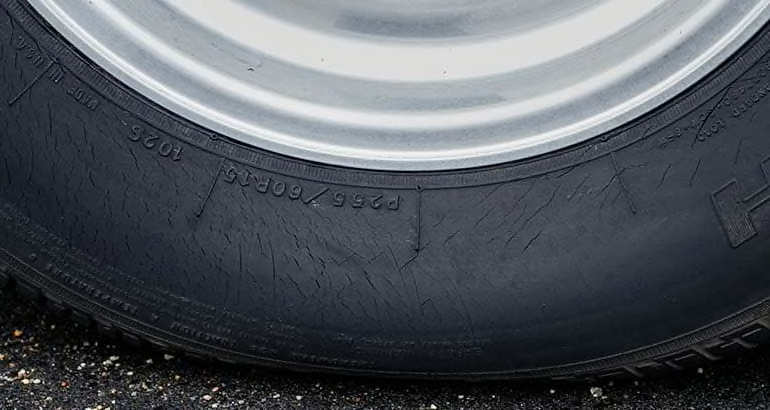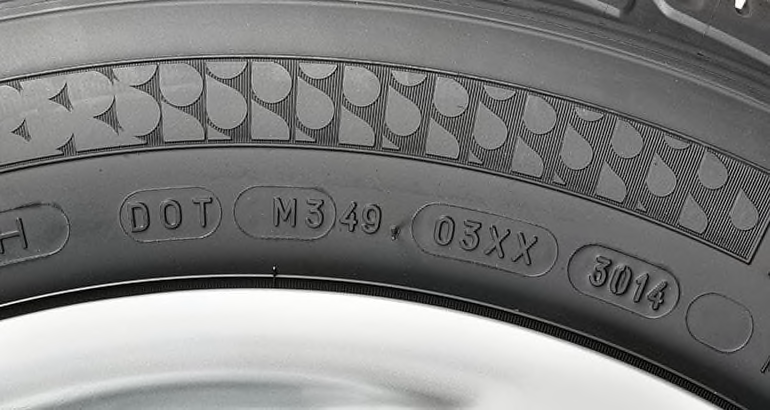Make a tire check part of your regular car maintenance routine, because it can improve your safety and boost your car's fuel economy. National Tire Safety Week takes place May 20-27, and it's meant to raise consumer awareness of the need for maintenance and safety.
Consumer Reports encourages those traveling over the long Memorial Day weekend to follow these quick tips. These checks should be performed monthly, but it's especially important to do one before embarking on long driving vacations.
A flat tire or other tire problem can be an inconvenience when you're far from home, and the heat that can build up in tires over a long drive at high speeds can make these problems worse.
The Basics of Tire Inspections
To get the most out of your car's tires, check their pressure monthly and visually inspect them for cuts, cracking, and bulges. Check the tread depth; it is recommended that you shop for replacement tires before the tires have become too worn down.
It's always best to buy tires in sets of four for the best balance of grip and handling. Shoppers can often get good deals when buying a full set. If you need only two new tires, place the new ones in the rear to help you maintain control on wet roads.
Uneven wear across the width of the tire can be a sign that the wheels have become misaligned, possibly after hitting a pothole or road debris. If you see this, have a professional check the tires. Likewise, it's always worth having tires aligned after you've bought new ones; that'll ensure they wear evenly. Rotate them periodically, per your owner's manual, which is typically every 5,000 to 8,000 miles.
Step 1: Check Tire Pressure
Air pressure is the life blood of a tire and should be checked monthly, not just seasonally. Maintaining proper pressure levels will maximize a tire's service life.
Tires lose pressure over time, and underinflation can cause a tire to flex more than it should and build up heat that can lead to its failure. Underinflated tires are also less fuel-efficient and may wear out faster.
The correct pressure for your tires can usually be found on a sticker on the driver's doorjamb of your car. Consult your owner's manual for additional information—not the tire's sidewall. You should check pressure when tires are cold, so measure it after the car has been parked for more than 3 hours. If you have a spare tire, check its pressure regularly, too.
Don't rely on your car's tire-pressure monitoring system (TPMS) to alert you when your tires need air. The system is not a maintenance reminder; it's designed to alert you that a tire is losing air and needs urgent attention. By the time the TPMS light comes on, your tires have are down in pressure by 25 percent or more.
See our tire pressure gauge ratings.
Step 2: Check Tread Depth and Worn Spots

The perfect tools for checking your tread depth cost just 26 cents. Grab a quarter and a penny to determine whether your tire has enough tread left or to see whether there's a wear concern.
Place the quarter upside down in a groove on your tire. The distance from the coin's rim to George Washington's hairline is about 4⁄32 inch. If you see all of Washington's head in any one groove where a treadwear indicator appears, you might want to start shopping for new tires while you have some seasonal grip left.
The penny will help you check for uneven tire wear. That can be a sign of misalignment, improper inflation pressure, or aggressive driving. Any major groove worn to 2⁄32 inch, the distance between the top of Lincoln's head to the edge on a penny, warrants immediate tire replacement.
Step 3: Check Tire Sidewalls

Encounters with potholes, curbs, and unfriendly objects in the road can leave cuts and bulges in your tires. If you find one of these abnormalities, it's time to replace the tire.
Some retailers offer free road-hazard warranties, and those are worth looking for when you shop for tires. (Read "Getting a Grip on Tire Warranties.")
Step 4: Check the Tire's Age

Every tire has a date code for when it was manufactured. Look for "DOT" followed by several digits on the lower sidewall of your tire. The last four numbers identify when the tire was made. As an example, the 3014 on the tire above indicates that the tire was manufactured in the 30th week of 2014.
Some automobile manufacturers recommend replacing tires after six years even if you haven't worn them out. CR recommends that any tires more than 10 years old should be replaced, regardless of wear.
Many manufacturers put the date code on only one side of the tire, as required by law. This can mean the date code is on the inboard side of the tire, under the car, making it difficult to read. Inside or outside, it's important to check that date code: It's possible that the tires were in inventory for months or longer before you bought them, so going by your purchase date will provide you with only a rough estimate.
Don't Buy Used Tires
Used tires may look fine at a glance, but they could have compromised durability if they've been misused in previous service, such as being driven while overloaded or underinflated, or if they were driven at excessively high speeds. Tires may also have been damaged when they were taken off their previous wheel.
When buying a used car, check out the tires. If they're worn, use that condition as a bargaining chip in your negotiations. Ask for service records along with the mileage and condition of the car. You may not know the complete history of the tires, but if the rest of the car has been neglected, chances are the tires have been, too.
Tips for the Perfect Road Trip
A road trip is one of life's great adventures. On the "Consumer 101" show, host Jack Rico learns from Consumer Reports expert Mike Monticello how to prepare for a safe one.
















